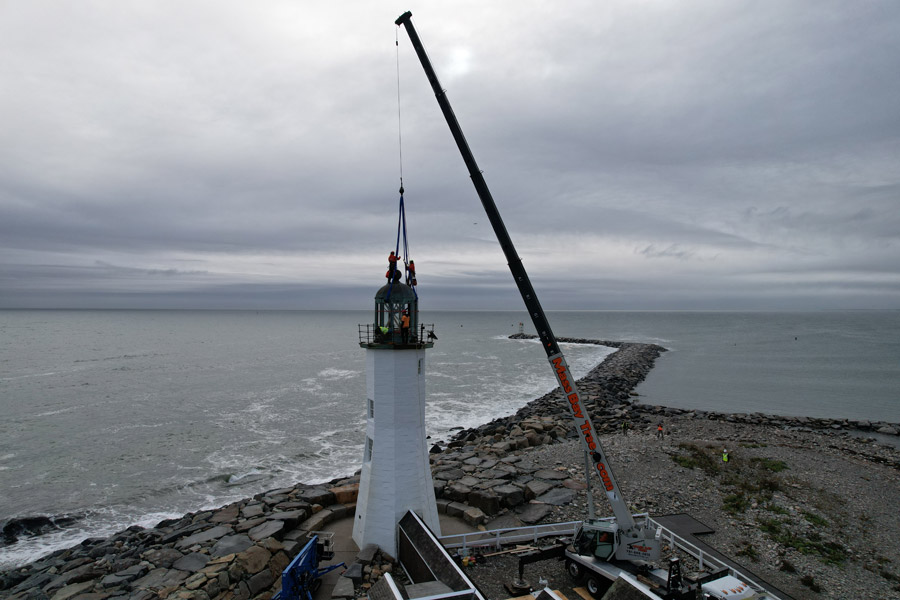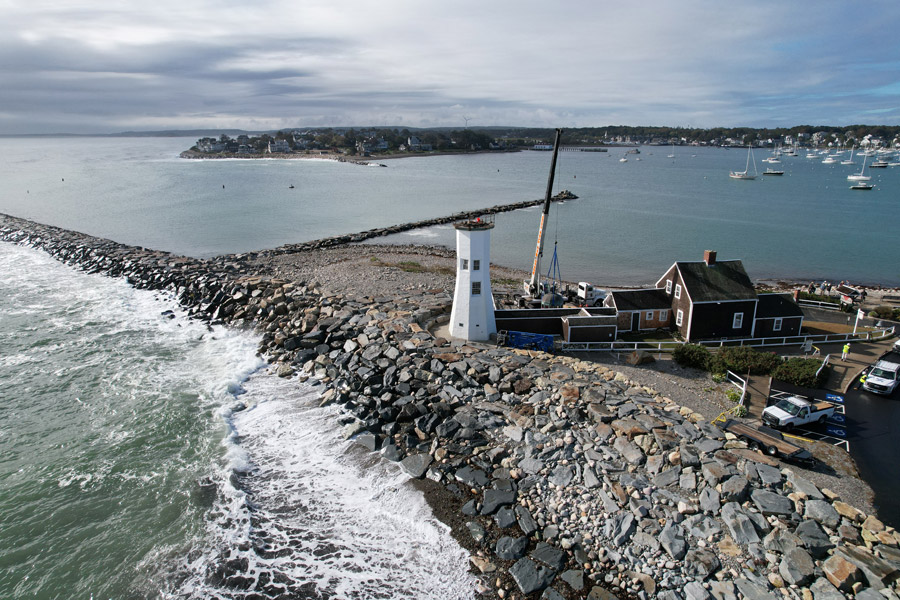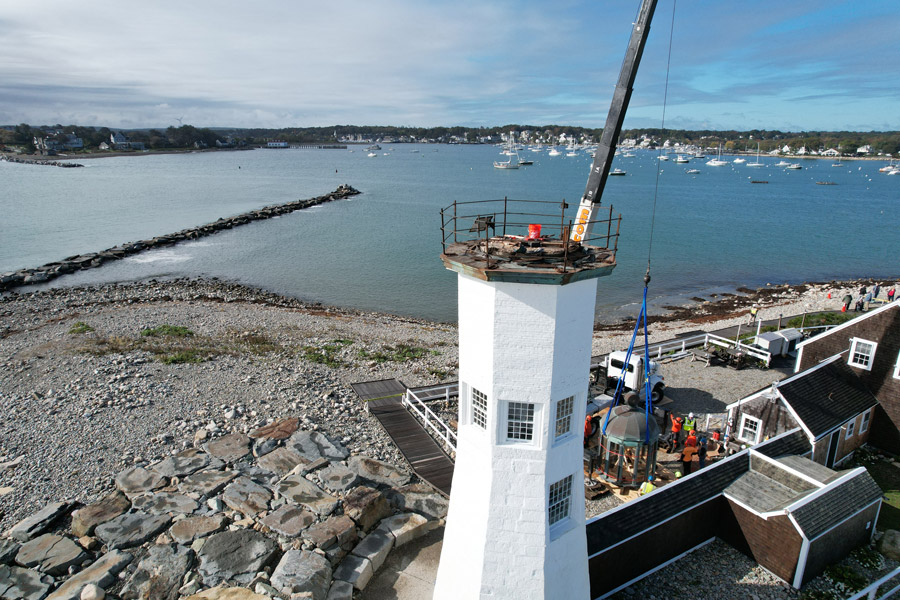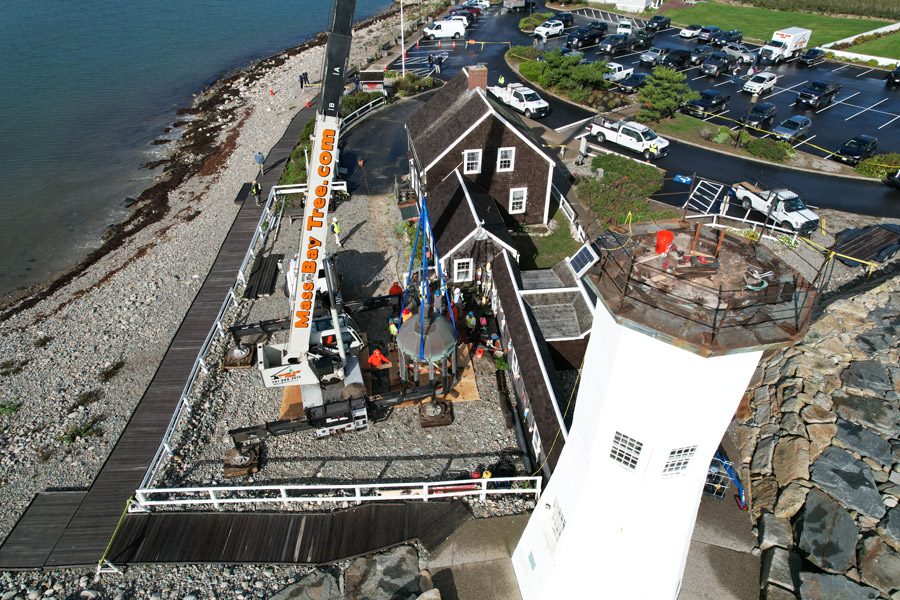Crews removed a 92-year-old historic lantern room from atop a lighthouse in Scituate, Mass. due to concerns it could topple and injure storm chasers venturing to the lighthouse point to catch crashing waves.
A 50-ton crane lifted the lantern on Oct. 6 during an approximately two hour-long operation, says Mike Gnazzo, president of Cenaxo, a Willington, Conn.-based architectural restoration firm that managed the lantern removal. On Oct. 11, as part of a discovery process, crews demoed a non-original concrete slab poured atop the original slab, then placed a temporary roof on the lantern, to complete phase one of a three-phase lantern room restoration project.

Mass Bay Tree Service workers attach crane rigging to lantern structure before hoisting it off the lighthouse.
Photo Courtesy of Pomroy Associates
The effort put Jim Boudreau’s mind at ease.
“I’m feeling better now that the lantern is down,” the Scituate town administrator said. “The next step is inspecting it to determine how to repair and replace it in the lighthouse next spring. The hard work comes now, but there were some tense moments waiting for the crane to pick it up and put it on the ground.”
Located south of Boston, Scituate issued an emergency order last fall to hire a contractor immediately after the Spenser Preservation Group completed an assessment of the tower and lantern room. The report confirmed the “lighthouse was imperiled, and the lantern room had to come down,” says Rick Pomroy of Pomroy Associates LLC, the town’s project manager.

The lantern room was lowered to the ground to rest behind the lightkeeper’s house where it will remain until renovations are completed next summer.
Photo Courtesy of Pomroy Associates
In April, the town appropriated $2.2 million to renovate the structure, not including the tower restoration. The Spencer Preservation Group is designing a new lantern room scheduled for installation on the tower next summer, Boudreau says.
Gnazzo said, like other historic preservation operations, conditions were more deteriorated than anticipated once they started the work. “We had to make some last-minute changes in how we shored up and supported the lantern structure,” he said.
Stabilizing the lantern involved installing two rings of wood blocking around the interior as well as a cable to hold the bottom of it together. The team braced across the lantern “in an X pattern to keep it all rounded,” Gnazzo says.

The Town of Scituate issued an emergency order to remove its lighthouse lantern room to avoid the risk of its toppling down onto spectators who visit the point to watch crashing waves in storms.
Photo Courtesy of Pomroy Associates
Initial planning of general sequencing with the team took weeks, but as the operation got closer, plans “got more detailed and the final sketches were within days prior to us hoisting the lantern,” Gnazzo recalls. “A lot of shoring and supports were in place to support the lantern from above, so once they hooked it up to the crane, we could cut it free at the bottom.”
Constructed in 1811, the lighthouse tower was added to the National Register of Historic Places in 1987, and the lantern room was installed in 1930 during the Great Depression. “A town is judged by its public buildings and its ground, and the town thought it should put a lantern on [its lighthouse],” says Robert Chessia of the Scituate Historical Society, “but it was not lit because it was not the navigational aid at the time, and it was very dangerous to light.”

View of lantern room foundation atop lighthouse stone tower after lantern room removal.
Photo Courtesy of Pomroy Associates
Pomroy, the town’s project manager, says the original installation is a copper-clad steel-framed tower that was never waterproofed well and leaked. The steel framing is a dodecagon light fixture with 12 faces and 12 columns framing it, Pomroy says. “Virtually all the columns that frame it with steel framing coming from the tower up through the lantern that the roof was fastened to had corroded away,” he says. “There was very little supporting the lighthouse so there was grave concern.”
The team is aiming to build a stainless-steel structure with appropriate waterproofing systems then copper clad. “They are dissimilar materials, but we want to achieve something close to what we have taken off [the lighthouse],” Pomroy says.
The team is now drawing up restoration documents and developing a prototype for the lantern, Pomroy says. It plans to complete those documents by December and go out to bid for the tower restoration and fabrication of a new lantern room with completion by early summer 2023.





